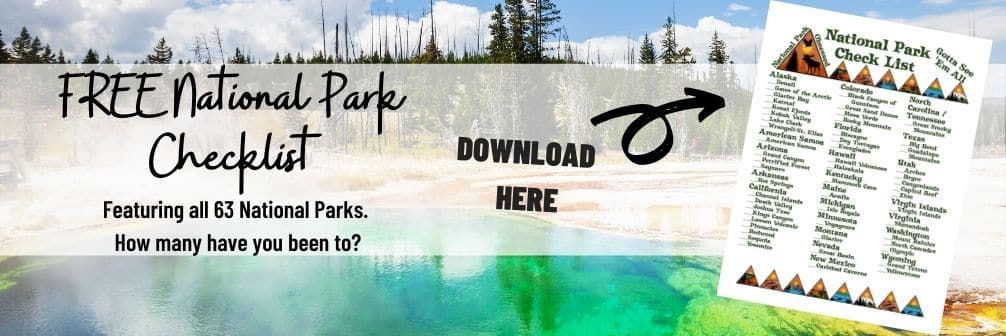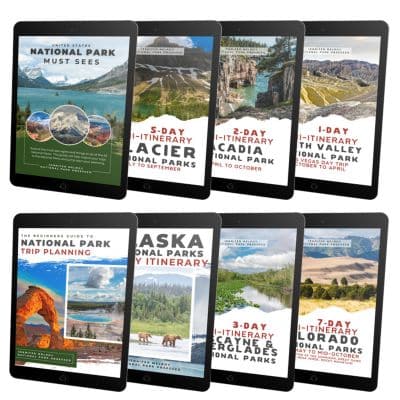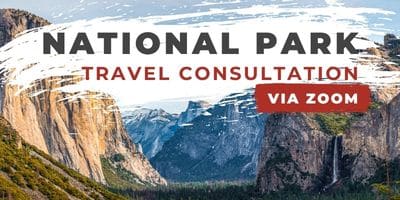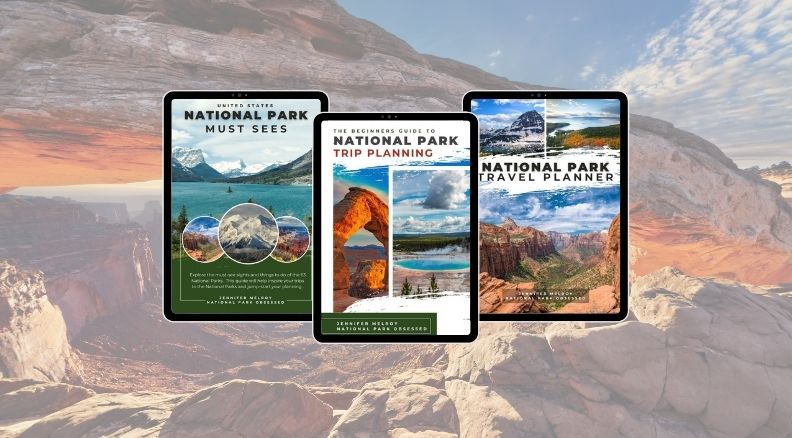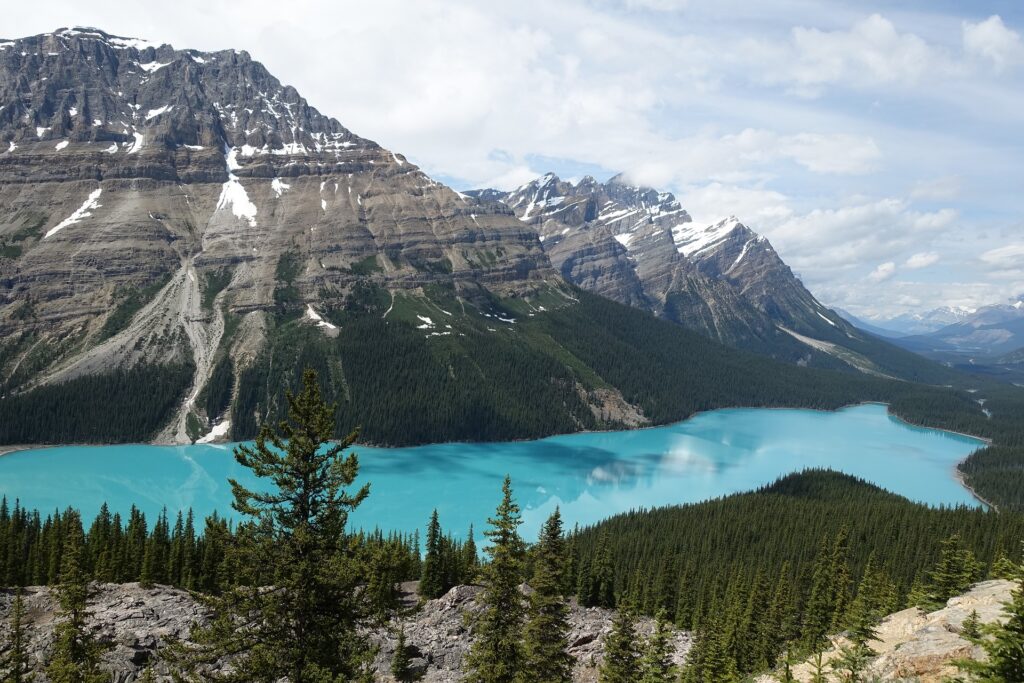
National Parks of Canada
- Jennifer Melroy
- Last Modified September 2, 2020
- First Published on November 9, 2019
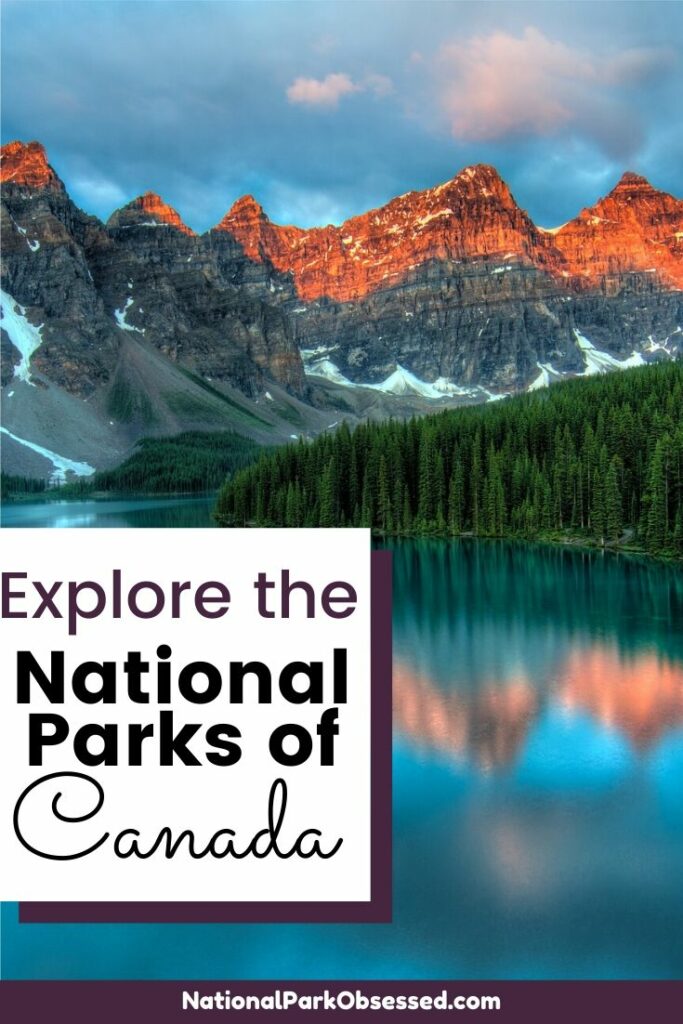
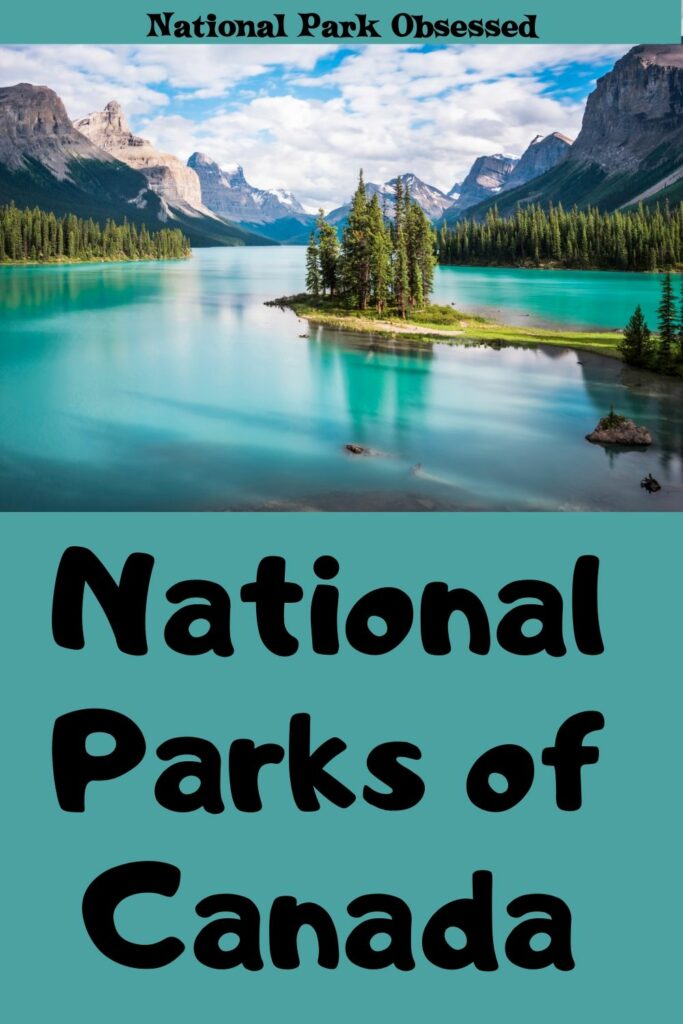
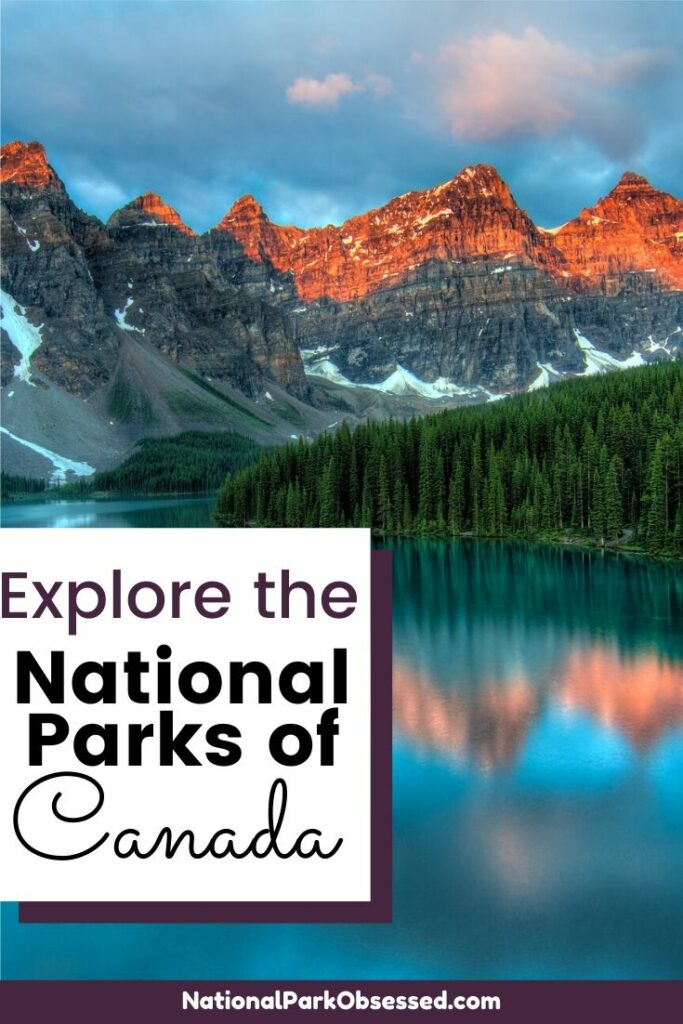
This post may contain affiliate links, meaning if you book or buy something through one of these links, I may earn a small commission at no extra cost to you! Read the full disclosure policy here
Canada is our northern neighbor. Like the United States is is a vast country with a range of landscapes from sea to sea. Canada’s National Park system protects many of the most important regions in this landscape.
There are currently 48 National Parks in Canada. Canada has 3 different kinds of national parks. There are sites that are national parks, national park reserves, and national urban park.
Official National Parks of Canada
- Akami-Uapishkᵁ-KakKasuak-Mealy Mountains National Park Reserve
- Aulavik National Park
- Auyuittuq National Park
- Banff National Park
- Bruce Peninsula National Park
- Cape Breton Highlands National Park
- Elk Island National Park
- Forillon National Park
- Fundy National Park
- Georgian Bay Islands National Park
- Glacier National Park
- Grasslands National Park
- Gros Morne National Park
- Gulf Islands National Park Reserve
- Gwaii Haanas National Park Reserve, National Marine Conservation Area Reserve, and Haida Heritage Site
- Ivvavik National Park
- Jasper National Park
- Kejimkujik National Park and Historic Site
- Kluane National Park and Reserve
- Kootenay National Park
- Kouchibouguac National Park
- La Mauricie National Park
- Mingan Archipelago National Park Reserve
- Mount Revelstoke National Park
- Nááts’ihch’oh National Park Reserve
- Nahanni National Park Reserve
- Pacific Rim National Park Reserve
- Point Pelee National Park
- Prince Albert National Park
- Prince Edward Island National Park
- Pukaskwa National Park
- Qausuittuq National Park
- Quttinirpaaq National Park
- Riding Mountain National Park
- Rouge National Urban Park
- Sable Island National Park Reserve
- Sirmilik National Park
- Terra Nova National Park
- Thaidene Nëné National Park Reserve
- Thousand Islands National Park (formerly St Lawrence Islands National Park)
- Torngat Mountains National Park
- Tuktut Nogait National Park
- Ukkusiksalik National Park
- Vuntut National Park
- Wapusk National Park
- Waterton Lakes National Park
- Wood Buffalo National Park
- Yoho National Park
Check out these 20 Amazing Pictures of Canada.
Help support this site by purchasing one of our National Park Shirts, Poster, and other gear. Every purchase includes a donation to the national parks and helps keep National Park Obsessed’s website free to use and producing more national park guides.
Looking for more help planning your next adventure? Join the National Park Obsessed Facebook Group here to connect other national park lovers, trade advice, or see inspiring photos of the National Parks?
- Alberta National Parks
- British Columbia National Parks
- Manitoba National Parks
- New Brunswick National Parks
- Newfoundland and Labrador National Parks
- Northwest Territories National Parks
- Nova Scotia National Parks
- Nunavut National Parks
- Ontario National Parks
- Prince Edward Island National Parks
- Québec National Parks
- Saskatchewan National Parks
- Yukon National Parks
Map of the National Parks of Canada
[show-map id=”83″]
Canada National Parks
Alberta National Parks
Banff National Park
Banff National Park was Canada’s first national park (and the world’s third) after being established in 1885. The arrival of the Europeans and the creation of the transcontinental railroad changed Banff forever as the “discovery” of the hot springs was seen as an opportunity to bring tourism to the area.
Nowadays, Banff National Park is a UNESCO world heritage site and whilst it is still famous for its hot springs, it is known throughout the world for its stunning mountains, mesmerizing blue lakes, and endless glaciers. A trip to Banff National Park should be on everyone’s bucket list. In the summer it becomes a hiker’s paradise with stunning trails taking you to breath-taking ridgelines, valleys, and summits. Tracks such as the Plain of Six Glaciers, The Larch Valley and Lake Agnes are some of the most spectacular day hikes you can do anywhere in the world.
For something more sedate, you can visit lakes with such vivid blue water that it looks photoshopped – Moraine Lake and Lake Louise are the most famous. These glacially fed lakes are a striking blue that has to be seen to be believed – they change colour throughout the day and are especially beautiful at sunrise. You may get lucky with seeing wildlife around these areas too – Moraine Lake, in particular, is a favourite haunt for grizzly bears (be sure to buy bear spray and keep it with you at all times when hiking).
Banff National Park is protected to preserve the fragile eco-systems and prolific wildlife that call the park home.
Cat Smith of Walk My World
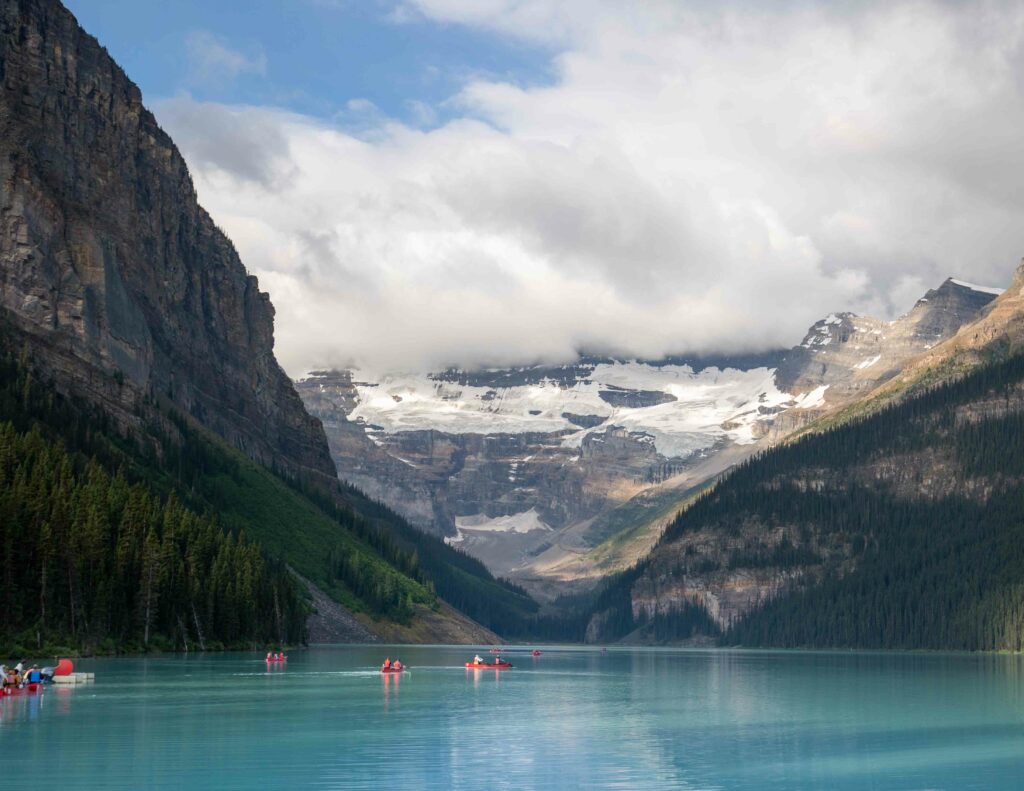
Elk Island National Park
Elk Island National Park is a gorgeous park just 35 minutes outside of the city of Edmonton. While not as popular as other parks in Alberta like Banff and Jasper, Elk Island has its own beauty that should not be missed. If you are traveling across Canada by train, you can easily get off at the Edmonton station and visit the park.
The park was founded in 1906 as an elk preserve to protect one of the last remaining big elk herds in the region. It was the first wildlife refuge in Canada!
Today, the park is home to a large number of Bison, which can be easily spotted. Elk Island has a number of important ecosystems, which you can learn about while walking along the boardwalk marked with information signs. The park is also one of Canada’s dark sky preserves, which in combination with its Northern location, makes it an ideal spot to view the Northern Lights.
During the summer you can visit the beach, kayak the lake, and camp under the stars. In wintertime, the park is still accessible and you can go snowshoeing or skiing. The park is a perfect for year-round activities and wildlife viewing, which is why it should remain protected for future generations to enjoy.
Lora Pope of Explore with Lora

Jasper National Park
Featuring jagged snow-capped peaks, sweeping glacial valleys, turquoise lakes and flowering alpine meadows, Jasper National Park’s legendary scenery makes the spectacular park one of the most popular wilderness areas in Canada.
Jasper was founded in 1907 and granted national park status in 1930. The park—in conjunction with the adjacent parks of Banff, Kootenai, and Yoho— was granted UNESCO World Heritage status in 1984.
Today, Jasper holds the distinction of being the world’s second-largest Dark Sky Preserve. As a result, one of the best places in the world to fall asleep under a canopy of stars.
The spectacular Icefield’s Parkway links Jasper and Banff. Known as one of the world’s most beautiful drives, the Icefield’s Parkway boasts jaw-dropping views at every turn. The 230km journey through the heart of the Canadian Rockies offers the opportunity to travel through protected wildlife habitats and witness some of the world’s most iconic mountain scenery.
Often overshadowed by its southerly neighbor, Banff, Jasper National Park has a host of its own noteworthy attractions. Beyond the Icefield’s Parkway, popular places to visit include the Columbia Icefield, Lake Maligne, the Edith Cavell Glacier, and Athabasca Falls.
Erika Bisbocci of Erika Travel’s

Waterton Lakes National Park
When planning a road trip in Alberta, Waterton Lakes National Park may seem a bit out of the way, but that is exactly why it should be added to the itinerary. It is less popular than its northernly mountainous neighbour of Banff but is no less stunning.
The area has a human history that dates back 10,000 years. Originally it was used as Bison hunting grounds by the Kutenai and Blackfoot. Both peoples passed through what is now the Crowsnest Pass area to hunt at the Waterton Lakes.
The movement to protect the beautiful region began in 1895. John George “Kootenai” Brown, the first park official, and Albert “Death-on-the-Trail” Reynolds, an American park ranger, pushed for this area, which stretched across both sides of the Canada/US border, to be considered one whole park. In 1932, Waterton, along with Glacier National Park in the US, was designated as the world’s first International Peace Park. In 1979 the region was named a UNESCO Biosphere Reserve and in 1995 it became a UNESCO World Heritage Site.
Waterton is an incredibly diverse park – more than half of all of Alberta’s plant species can be found there! Ecologically, it covers the Great Plains, the Rocky Mountains, and the Pacific Northwest. In the 2018/19 season, over 412 thousand people visited the park.
Today, there are many things to do in the small town Waterton and the surrounding natural area. Explore the 200 kilometers of hiking trails, stay overnight in one of three campgrounds in the park, and of course, there is canoeing and scuba diving in the lakes. Parks Canada also offers some impressive interpretive programs including visits to discovery stations, guided bird walks, and even photography classes.
Dalene Heck from Road Trip Alberta
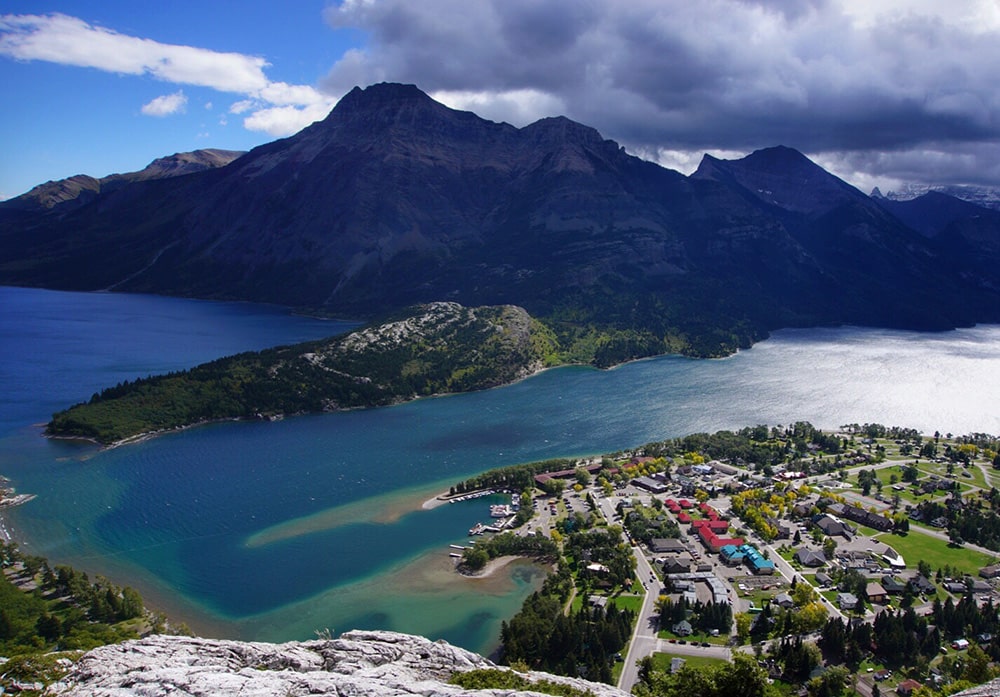
Wood Buffalo National Park
Straddling the border between the Northwest Territories and Alberta, Wood Buffalo National Park has a number of claims to fame. Not only is it Canada’s largest national park but it’s also the world’s largest dark sky preserve. Yes stargazers, you’ll never have a problem seeing the aurora here! Wood Buffalo National Park was established in 1922 to help protect the world’s largest free-roaming herd of bison. This was also one of the reasons it received UNESCO World Heritage Status. Wood Buffalo is also home to one of two nesting grounds for the endangered whooping crane – the tallest bird in North America.
Lastly, you’ll also find the only salt plains in Canada within the park! This is definitely a must when planning a visit to the park. There are a number of great hikes from roaming on what feels like a martian landscape to meandering through a typical bison habitat. Whether you visit to enjoy the trails and wildlife during the day or to snap some starry shots at night, you’ll fall in love with Wood Buffalo National Park.
Lindsay Davies of I’ve Been Bit! Travel Blog

British Columbia National Parks
Glacier National Park
British Columbia’s Glacier National Park is often confused with Montana’s Glacier National Park. Glacier National Park protects the northern end of the Selkirk Mountains. While located near the Canadian Rockies National Parks of Banff/ Jasper/ Yoho/ Kootenay, these mountains are geologically distinct from the Rockies. The area is often called the “Canadian Alps.”
This mountainous park is home to five mountains over 8,000 ft and is home to 131 glaciers. The glaciers have shrunk considerably since the park was created.
Glacier National Park was created on October 10, 1886, and is the second oldest Canadian National Park. It is at the crossroads of the Trans-Canada Highway and the Candian Pacific Railway. This easily accessed park is a hiker and climbers dream. There are miles and miles of trail to explore. Climbers and Mountaineers consider this area to have some of the classic great North American climbs. Less adventurous visitors will enjoy the scenic drives and vistas.

Gulf Islands National Park Reserve
The Gulf Islands National Park Reserve is a protected space located on the Gulf Islands of British Colombia. The park is made up of 16 islands and the surrounding waters. The park covers 14 square miles. These islands have a climate similar to the Mediterranean climate. The summers are dry, sunny while the winters are mild and wet. The island’s vegetation is similar to the other areas of the Pacific Northwest.
The park offers visitors a range of activities from hiking to kayaking. There is plenty to explore and the chance to see a range of mammals such a seals and sea lions as well as migrating shorebirds. Visitors are also welcome to harvest up to six pieces of fruit from one of the parks 17 historic orchards.
The Gulf Islands National Park Reserve was created on May 9, 2003. This is the sixth smallest National Park in Canada.
Gwaii Haanas National Park Reserve, National Marine Conservation Area Reserve, and Haida Heritage Site
Gwaii Haanas translates to ‘Islands of Beauty’, and that it certainly is! Located off the west coast of British Columbia on the archipelago of Haida Gwaii, this is the only park in the world that offers protection from ‘mountaintop to seafloor’. There are around 500 identified Haida heritage sites within the park’s boundaries, making it one of the most popular things to do in Haida Gwaii. Access to the park is by boat or air only. So, unless you have your own boat, kayak or seaplane, you will have to organise your trip through a tour operator.
Everyone entering Gwaii Haanas must attend an orientation, lasting about 1.5hrs, but this is a fascinating introduction to the park’s cultural and natural history, as well as providing all the legal safety and protocol information. If you are using a tour company, they will arrange this and collect your park entrance fee (Adults $19.60, Seniors $16.60, children 0-17 Free). If you are undergoing a self-guided trip, you will have to attend the orientation and pay your fee at The Haida Heritage Centre in Skidegate. In an attempt to preserve both the cultural history and the delicate ecosystem, there is a limit of 12 people at a site at any one time, allowing everyone to enjoy the wilderness of Gwaii Haanas without feeling crowded by other tourists.
I recommend a multi-day trip to allow enough time to visit several Haida heritage sites and explore the untouched forest, but if your time or budget does not allow for this, day trips are possible but you will have to be selective about what you see and do. The totem poles and longhouses in Nang Sdins Llnagaay (Ninstins) on SGang Gwaay (Anthony Island) are a UNESCO World Heritage Site. The remains of other villages can also be visited at T’aanuu Llnagaay (Tanu), K’uuna Llnagaay (Skedans), Hlk’yah GawGa (Windy Bay) and Gandll K’in Gwaay.yaay (Hotspring Island). A relaxing soak in the hot springs with a spectacular view of neighbouring islands is a perfect end to a hike! There are no established trails, but you are free to explore the park at your leisure. Just watch out for bears!
Joss Hooren of The Little Green Globetrotter

Kootenay National Park
Kootenay National Park is one of the Canada’s premiere Rocky Mountain National Parks. The park includes parts of the Kootenay and Park mountain ranges and the entirety of Vermillion River. The park is 543 square miles. One of the most interesting features of the park is the Paint Pots. These acidic, cold water mineral springs and supports a unique ecosystem that included extremophilic bacteria.
Hikers will love this park. It has a range of trails from short day hikes to multi-day hikes that extend into Banff National Park and Yoho National Park. Visitors are also attracted to Radium Hot Springs so they can soak in the warm water. Despite the name the water is not radioactive.
Kootenay National Park was created on April 21, 1920 and the park is part of the Canadian Rocky Mountain Parks World Heritage Site.
Mount Revelstoke National Park
Mount Revelstoke National Park is located in central British Columbia in the Selkirk Mountains. It’s named after the nearby mountain town of Revelstoke, a great destination for adventure travel. Locals blazed trails up the mountain and discovered the incredible beauty of the high alpine lakes and meadows carpeted in wildflowers. Thanks to their advocacy, it was declared a National Park in 1914.
Between 1912 and 1927 first locals and then the National Park worked on building the Meadows in the Sky Parkway. This 26km-long summer-only road winds up from the valley bottom to near the summit of Mount Revelstoke. Along the way, there are several viewpoints of the Columbia River valley below and the surrounding mountains.
Near the top, the sides of the road are covered in wildflowers in July and August. From the end of the parkway at Balsam Lake, you can take a shuttle bus or hike the 1-kilometre-long Upper Summit Trail to the peak.
At the summit, there is a historic fire lookout, built in 1927, which is now a federally registered heritage building. You can also take short walks to several viewpoints or hike interpretive trails that explain the history of explorer David Thompson and the local First Nations people. You can also follow trails deep into the alpine backcountry.
Unlike the nearby Rocky Mountains, the Revelstoke area has a uniquely warm climate with lots of rainfall. This means that the valley bottom is home to the world’s only inland temperate rainforest with lots of towering old-growth cedars covered in gorgeous green moss.
The Trans-Canada highway runs along the southeastern side of the park, giving access to several low elevation trailheads. The best place to experience the rainforest is on the Giant Cedars Boardwalk Trail. This 0.5-kilometre loop has interpretive signs to help you learn about the unique ecosystem.
Taryn Nicole of Happiest Outdoors

Pacific Rim National Park Reserve
If you make the journey to the rugged west coast of Vancouver Island, you’ll be rewarded with one of the most spectacular untouched stretches of land that I’ve ever had the privilege of seeing.
Pacific Rim National Park Reserve, established in 1970 to protect the coastline from an influx of tourists, is divided into three separate pieces.
The largest and most accessible part is the Long Beach unit, which you’ll find along Highway 4 between Tofino and Ucluelet. Of the three areas, the Long Beach unit is the only one that you’ll be able to reach by car.
The Broken Group Islands off the western coast and the West Coast trail on the southwest coast of Vancouver Island make up the other two pieces of the park.
The Broken Group islands are a popular destination for adventurous sea kayakers, while the West Coast Trail near Port Renfrew (75km long) is one of the most stunning backpacking trails in the world. In total, the National Park is 511 square kilometers.
The list of things to do in Pacific Rim National Park is nearly endless. Storm watching. Rainforests. Sandy beaches. Surfing. Whale watching. Backpacking. Sea kayaking. The list goes on. No matter what you’re into, there’s something for you on the west coast of Vancouver Island.
Outdoor lovers should backpack the West Coast Trail, which will take you through dense and damp rainforests, and across untouched sandy beaches. For a shorter day hike, hike the Willowbrae Trail to Florencia Bay and Half Moon Bay near Ucluelet.
Matt Hansen of Wheatless Wanderlust

Yoho National Park
One of the best national parks in Alberta is Yoho National Park. It shares the eastern border with the famous Banff National Park, and to the south, it shares a border with Kootenay National Park. The park was established in 1886 the same day as Glacier National Park. It is the second oldest national park in all of Canada. This beautiful national park is protected due to the Burgess Shale sites featuring fossils from 540 million years ago.
One of the best attractions in this national park is Emerald Lake. This stunning blue turquoise lake is surrounded by tall stunning mountains and beautiful evergreen trees.
Another great place to stop at is Takakkaw Falls. This waterfall is 373 meters, making it the 2nd tallest waterfall in Canada! Driving there can be a little nerve-racking. It is a very windy road with not much room for the number of cars, but if you can get there, you will be greeted with a splendid waterfall.
Michelle Stelly of The Wandering Queen

Manitoba National Parks
Riding Mountain National Park
Riding Mountain National Park protects three different ecosystem – grasslands, upland boreal forest and eastern deciduous forest. The park is located on the Manitoba Escarpment, an area of hills. Riding Mountain is the highest point in the park.
The park offers a range of outdoor activities from hiking to biking to water activities.
Riding Mountain National Park was created on May 30, 1933 and the park is a UNESCO Biosphere Reserve.

Wapusk National Park
Wapusk National Park is an isolated national park in northern Manitoba along the Hudson Bay. The park protects an important polar bear breeding habitat and the Hudson Bay Lowlands which consist of the muskeg and wet peatlands.
Wapusk National Park has limited access. There are no roads or hiking trails in Wapusk. Access is limited to select authorized commercial tour operators. Most of the tour operators focus on animal tourism – Beluga Whales and Polar Bears. These tours operate on the Hudson Bay near the park with occasional ventures into the park depending on wildlife viewing opportunities. The only tour focused on the park is the Wapusk helicopter flights.
Wapusk National Park was created 1996.
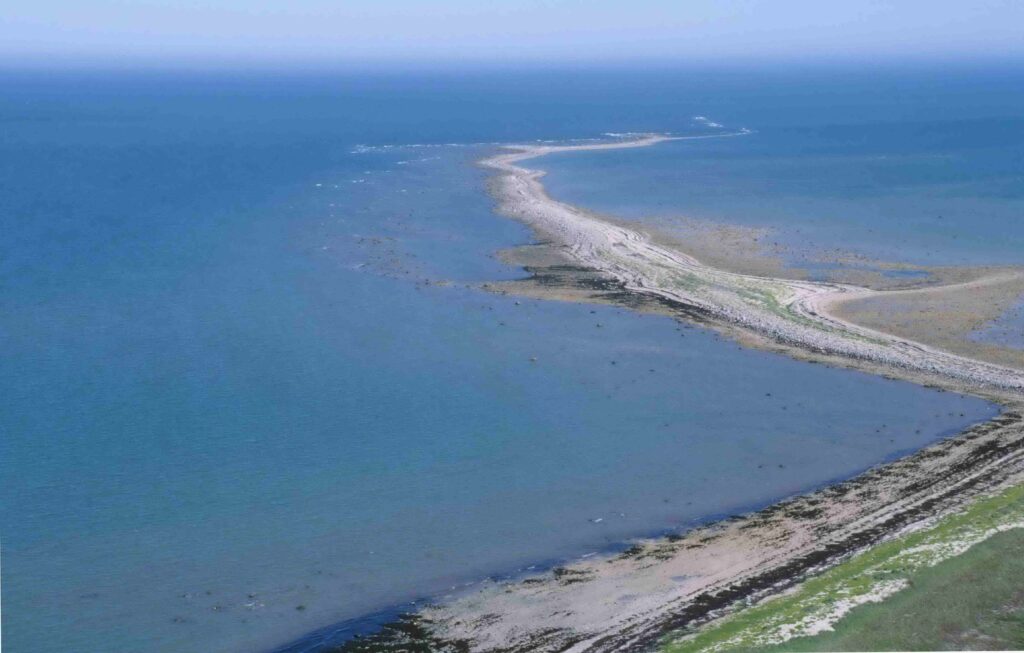
New Brunswick National Parks
Fundy National Park
Fundy National Park occupies an 11-mile stretch of coastline along the Bay of Fundy in New Brunswick’s southeastern corner. Established in 1948, it’s one of only two national parks in the province, and at 80 square miles, it’s one of Canada’s smallest. It’s a fairly accessible park for residents of northern Maine and the Maritime Provinces, though, since it’s less than a four-hour drive from all of their major cities. The park’s small size also means it can be thoroughly explored over a long weekend, something that can’t be said of Canada’s larger and more famous parks like Jasper and Banff.
One of Fundy’s main draws is its spectacular 70-foot-high tide, which is the largest in the world. At its low point, it exposes up to three miles of ocean floor and a bevy of aquatic creatures (be sure not to touch enough of them, though!). These large tides create an ecosystem that’s unlike anywhere else in the world, and the region’s uniquely high biodiversity was one of the main reasons it was designated as a national park.
Interesting as the tidal forces might be, Fundy also has over 60 miles of hiking trails connecting its hinterlands to the shore. Walking for just a few hours, you can experience several different ecosystems, with lush coastal rainforest near the ocean giving way to coniferous forests at higher elevations away from the water. Kayaking is also a popular activity in the park. Novice paddlers will find a home in the protected waters at the mouth of the Point Wolfe River, while more experienced sea kayakers will love the big waves out in the Bay of Fundy. You might be surprised to find that the park also has a nine-hole golf course and a swimming pool, as well as luxurious glamping tents for rent.
Ryan Victor of Passions and Places

Kouchibouguac National Park
Kouchibouguac National Park protects an area of sensitive sand dunes and blogs along the east coast of New Brunswick.
Kouchibouguac National Park was created in 1969.
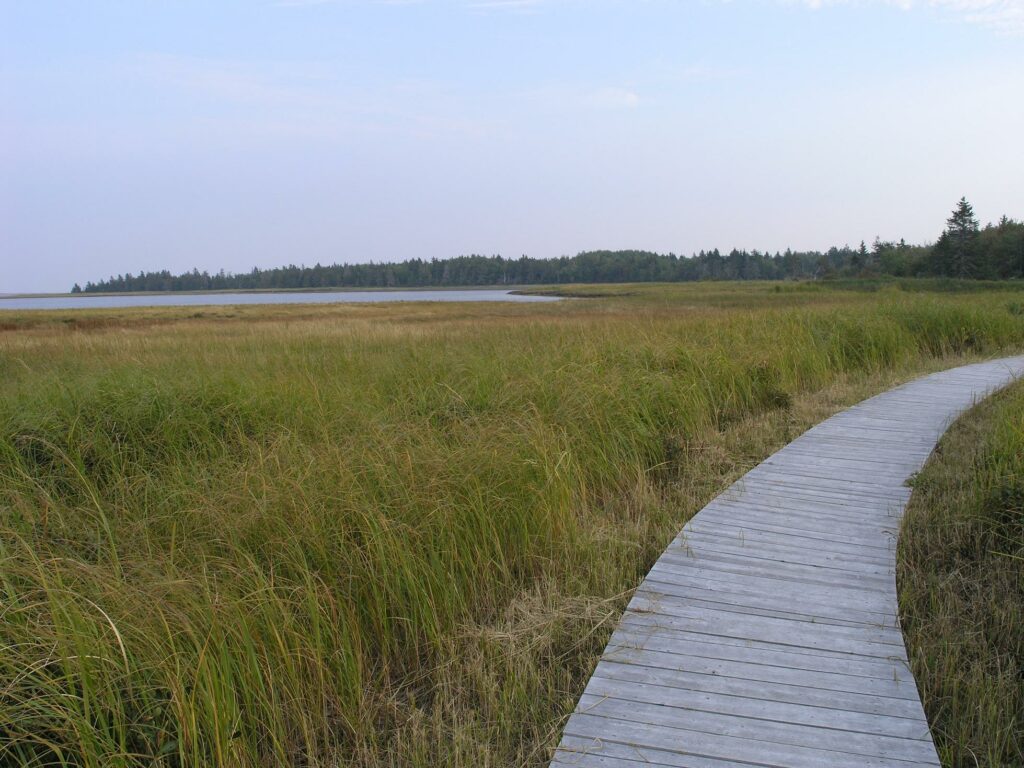
Newfoundland and Labrador National Parks
Akami-Uapishkᵁ-KakKasuak-Mealy Mountains National Park Reserve
Akami-Uapishkᵁ-KakKasuak-Mealy Mountains National Park Reserve was created on 2017.
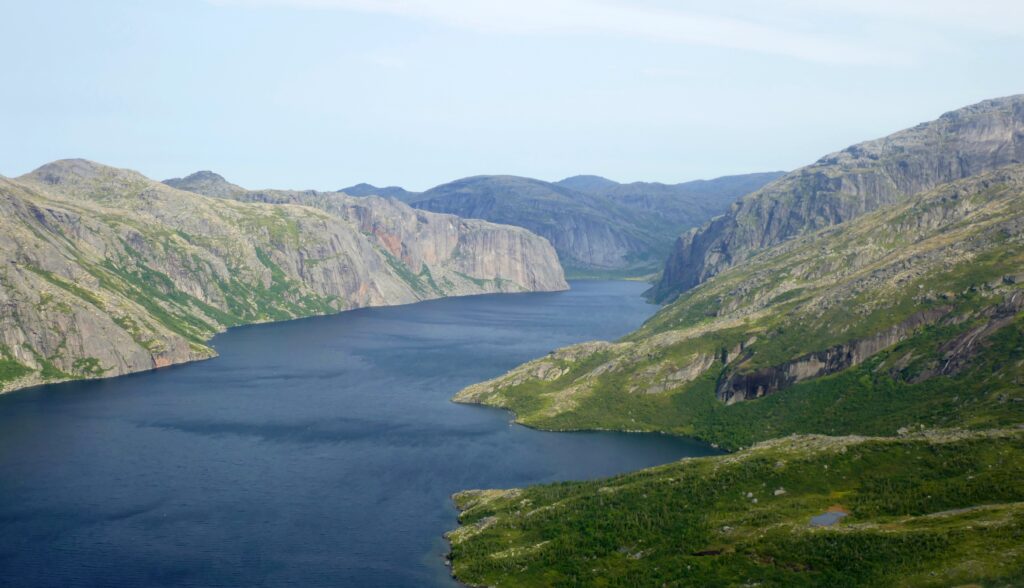
Gros Morne National Park
Gros Morne National Park is located on the west coast of the island portion of Newfoundland and Labrador. I was so fortunate to have worked in this incredible park throughout university and it has remained in my heart. The park is absolutely stunning with an incredible variety of landscapes and natural beauty. This beauty is linked to an incredible geological history that must be protected.
The park is one of the world’s best examples of continental drift and plate tectonics. Areas of the park give proof that 400 million years ago tectonic plates did collide resulting in the earth’s mantle creating some of the world’s greatest mountain peaks and landscapes. The park also evidences glaciation which took place thousands of years ago. In fact, the glacial and geological history of Gros Morne resulted in it being named a UNESCO World Heritage site in 1987.
Gros Morne is a travel destination like no other. Whether travelling as a family or on their own, visitors have a large choice of unique activities ranging from easy to difficult which will allow them to experience all these geological wonders as they explore the park.
Just a few of these activities include taking a boat ride down the fjord at Western Brook Pond, walking on the earth’s mantle, an orange moon-like surface, at the Tablelands and hiking to the top of Gros Morne mountain itself. While there they may even see some of the park’s incredible wildlife including caribou, moose, snowshoe hare, arctic fox, beavers and more!
Joanne of the family travel blog Sunsets and Roller Coasters.
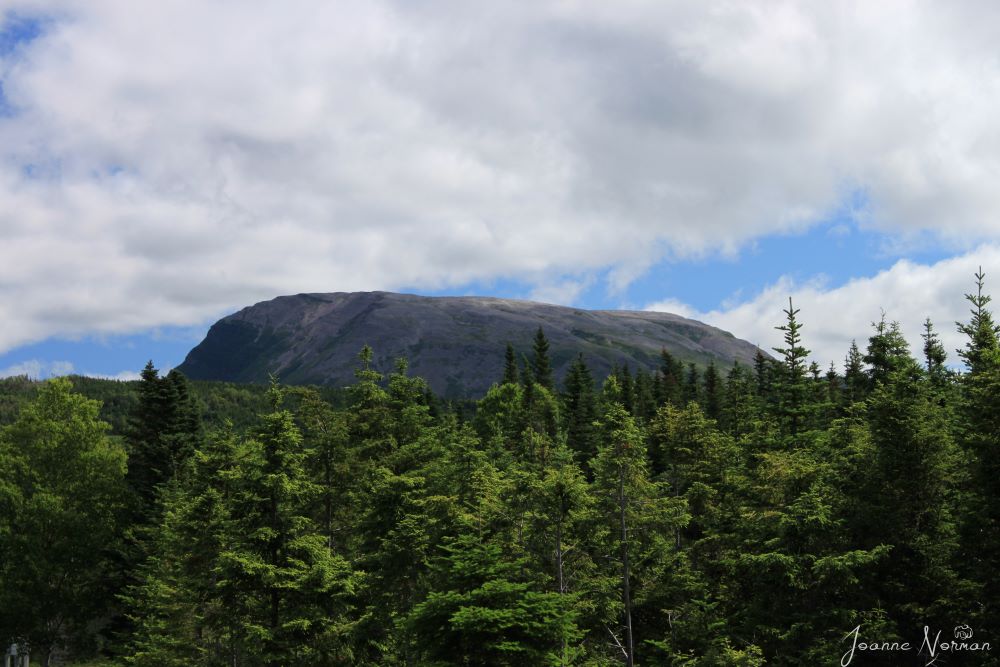
Terra Nova National Park
Terra Nova National Park was created in 1957.
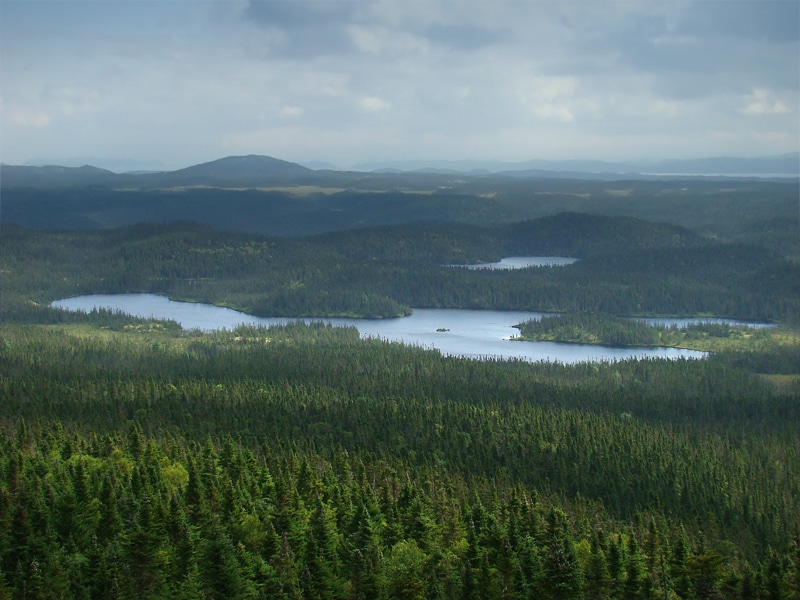
Torngat Mountains National Park
Torngat Mountains National Park was created in 2008.
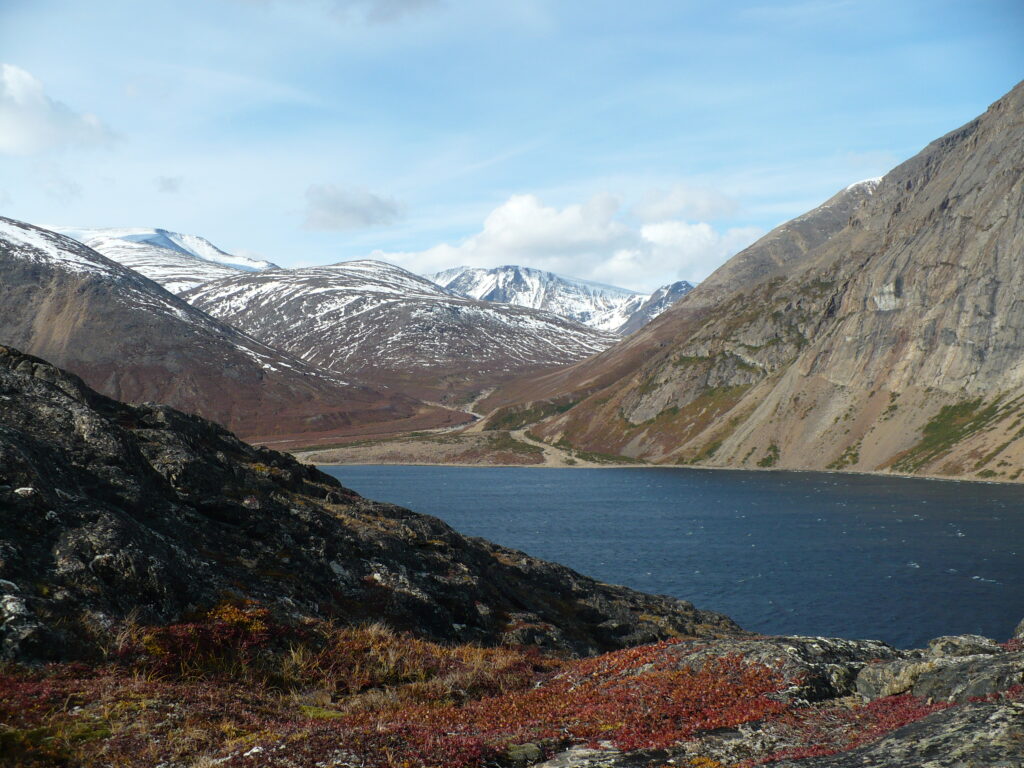
Northwest Territories National Parks
Aulavik National Park
Aulavik National Park was created in 1992.
Nááts’ihch’oh National Park Reserve
Nááts’ihch’oh National Park Reserve was created on December 18, 2014.
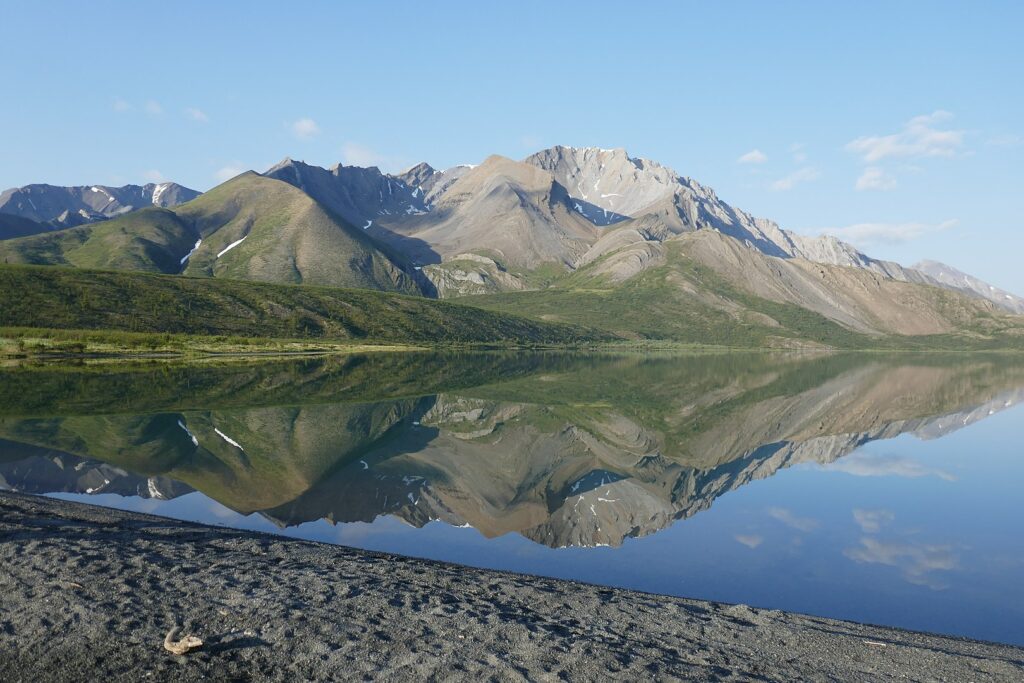
Nahanni National Park Reserve
Nahanni National Park Reserve was created in 1972.
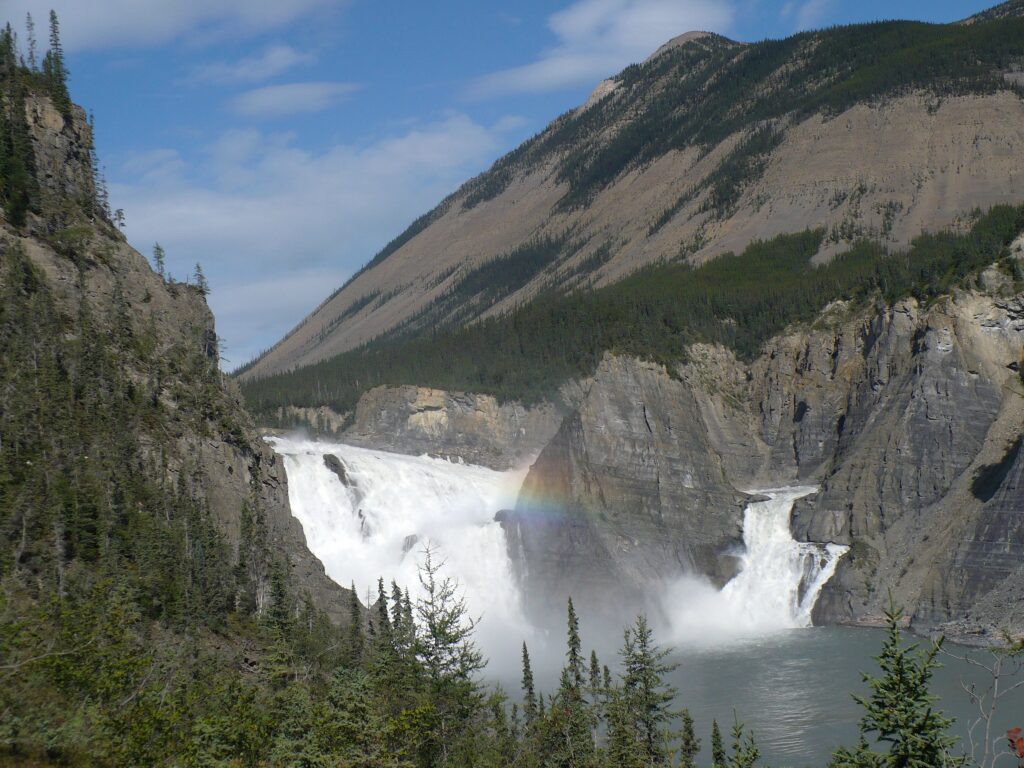
Thaidene Nëné National Park Reserve
Tuktut Nogait National Park
Wood Buffalo National Park
Straddling the border between the Northwest Territories and Alberta, Wood Buffalo National Park has a number of claims to fame. Not only is it Canada’s largest national park but it’s also the world’s largest dark sky preserve. Yes stargazers, you’ll never have a problem seeing the aurora here! Wood Buffalo National Park was established in 1922 to help protect the world’s largest free-roaming herd of bison. This was also one of the reasons it received UNESCO World Heritage Status. Wood Buffalo is also home to one of two nesting grounds for the endangered whooping crane – the tallest bird in North America.
Lastly, you’ll also find the only salt plains in Canada within the park! This is definitely a must when planning a visit to the park. There are a number of great hikes from roaming on what feels like a martian landscape to meandering through a typical bison habitat. Whether you visit to enjoy the trails and wildlife during the day or to snap some starry shots at night, you’ll fall in love with Wood Buffalo National Park.
Lindsay Davies of I’ve Been Bit! Travel Blog
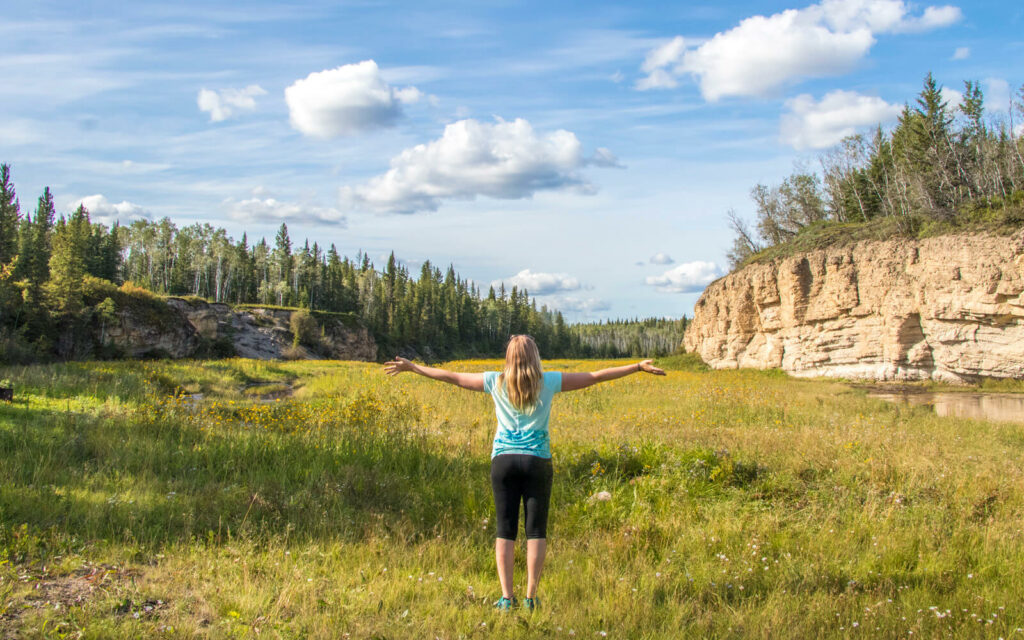
Nova Scotia National Parks
Cape Breton Highlands National Park
Kejimkujik National Park
Sable Island National Park Reserve
Nunavut National Parks
Auyuittuq National Park
Qausuittuq National Park
Quttinirpaaq National Park
Sirmilik National Park
Ukkusiksalik National Park
Ontario National Parks
Bruce Peninsula National Park
If you’re looking for awesome hiking, sweeping views, and an escape into nature then head Bruce Peninsula National Park. Located a few hours’ drive north of Toronto, the park covers over 150 square kilometers and was established in 1987. It’s one of the largest protected areas in southern Ontario and home to birds, mammals, and over 30 species at risk.
There is a wealth of reasons to visit the Bruce Peninsula National Park. One of the most popular attractions is the famous Grotto, a sea cave located along the limestone cliffs of the park. Many flock to the park to enjoy camping, attend the Orchid Festival, go bird watching, and even climb the fire tower for views over the park as well as Fathom Five National Marine Park. But it’s the Bruce’s incredible hiking trails that keep people coming back, like the Bruce Trail. With sweeping cliff-top views over the crystal blue waters of Georgian Bay and diverse landscapes, the Bruce Peninsula National Park’s hiking trails attract people from around the world.
Over the past few years park visitor numbers have skyrocketed. So much so that the parking lot leading to the most popular attraction in the park, the Grotto, has timed slots that must be booked online in advance. Sadly, the rise in park visitors in the summer months has caused detrimental harm to the park, its ecosystem, and the precious Niagara Escarpment that runs through it. The park staff has been working tirelessly to clean up the park, educate visitors and ensure the safety of the park’s wildlife.
A few tips to keep in mind when visiting the park is to always track out your waste, bring a bag to pick up litter along the way, stay on the trail, and try visiting in the offseason.
Stephanie Mayo from The World As I See It
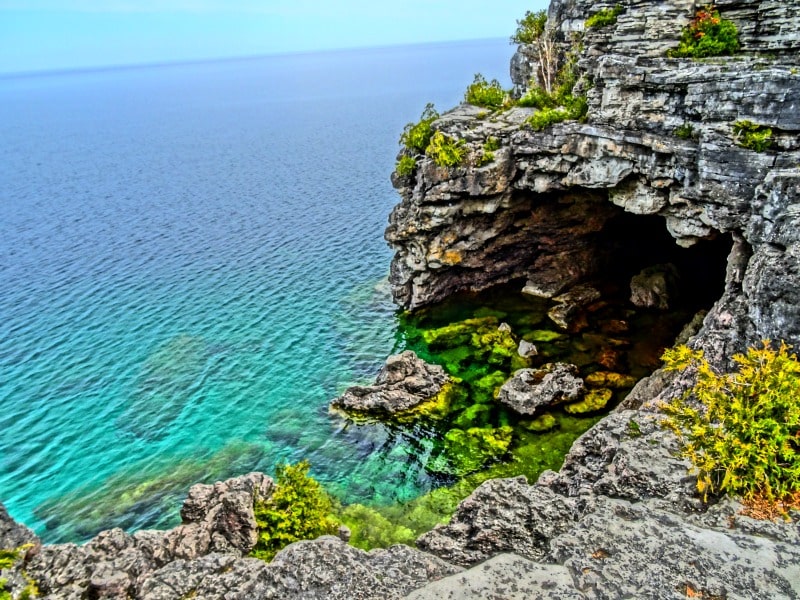
Georgian Bay Islands National Park
Say hello to the world’s largest freshwater archipelago! Georgian Bay Islands National Park is composed of 63 islands and covers just 14 kilometers squared, making it Canada’s smallest national park! While the majority of the islands remain untouched, Beausoleil Island is the perfect destination for nature lovers.
From wildlife watching to hiking to camping under the stars, it’s the perfect place to disconnect. While a day trip to Georgian Bay Islands National Park is always a great adventure, I highly recommend staying overnight. This way you can truly enjoy everything the park has to offer. You’ll need to do a little bit of planning to visit though as Georgian Bay Islands National Park is only accessible by water. Their DayTripper shuttle runs from mid-May to the Thanksgiving weekend in October and it fills up in the summer. Be sure to book your tickets in advance to avoid any disappointment!
Lindsay Davies of I’ve Been Bit! Travel Blog

Point Pelee National Park
Located at the southernmost point of mainland Canada, sits Point Pelee National Park. This park is shaped like a triangle, jutting down into Lake Erie.
Point Pelee is one of Canada’s most ecologically diverse parks. Thousands of birds flock here on their migratory routes, resting in the food-rich marshland that makes up most of the park.
At the Marsh store, you can rent a canoe to paddle into the marshlands. Try to spot as many species of birds as you can. There is a short route you can take and if the winds are calm you can paddle all the way to the East Access Beach. If you don’t want to paddle, you can jump onto the 1.4-kilometer boardwalk loop trail that leads you through the marshland. Don’t miss the views from the lookout tower!
Along the western side of the park, there are ten access points to the 20-kilometer long beach, where you can swim, have a picnic or take a hike.
There are no campsites located in the park, however, Point Pelee does offer 24 oTENTiks, which are A-frame yurts that have beds, tables and a camp kitchen station. If you don’t snag a campsite, there are many places to stay nearby, or make it a day trip!
The best experience is walking to the very tip of Point Pelee and stand at the southernmost point. During the summer months, park your car at the Visitor Centre and hop on the shuttle that drops you off less than a kilometer from the tip.
Did you know the tip is always moving? The shoreline shifts and alters its shape with the constant berating of waves and storms.
Oliva Rutt of My Wandering Voyage

Pukaskwa National Park
Rouge National Urban Park
Thousand Islands National Park
(formerly St Lawrence Islands National Park)
Thousand Islands National Park is one of six national parks in Ontario, Canada. Even though it’s one of the smallest national parks in Canada, it’s home to an extremely important ecosystem. The 1000 Islands are part of the Frontenac Arch Biosphere Reserve, recognized as a UNESCO Biosphere Reserve because it is the most biodiverse area of Canada. Five different forest regions meet at this point, creating a diverse ecosystem of plants and animal species, particularly some that are at risk. Thousand Islands National Park has a spectacular landscape consisting of captivating pine tree forests, rugged shorelines, and islands that are actually the peaks of ancient mountains.
The national park includes 20 islands and three mainland properties. While you can go hiking and explore nature throughout the national park, most of it is accessible only by small boat. Part of the adventure is navigating around the islands by kayak or canoe, so it’s a dream for outdoor adventure enthusiasts. While it makes sense to visit the Thousand Islands National Park during the warmer summer months, it’s a stunning region to check out in the fall. The fall colours put on a dazzling display in September and October, and the crowds thin out after the Labour Day long weekend.
Lauren Yakiwchuk of Justin Plus Lauren
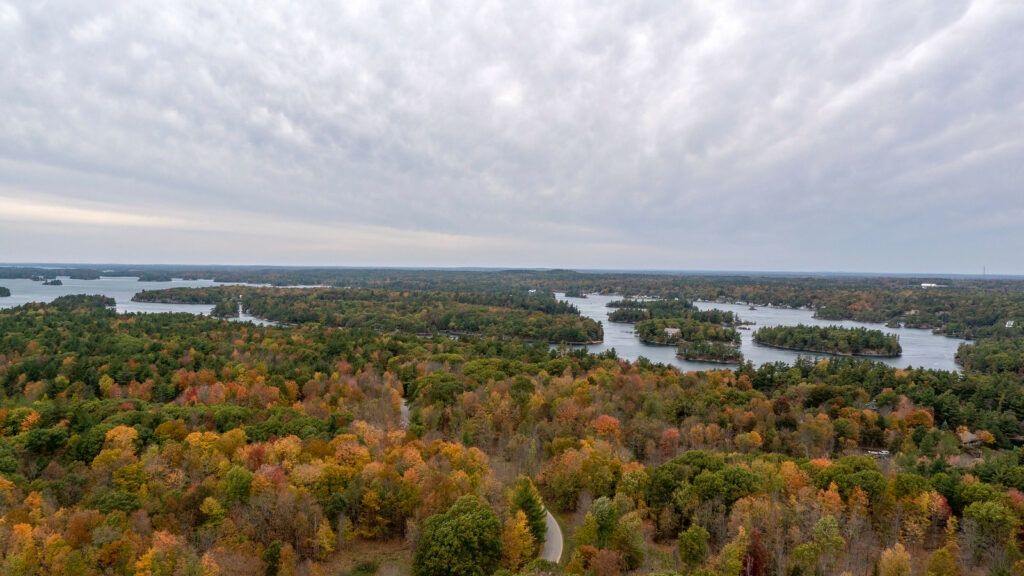
Prince Edward Island National Parks
Prince Edward Island National Park
Prince Edward Island National Park takes up a large section of PEI’s northern shore, including towering dunes, red cliffs and sandy beaches.
The three sections, Cavendish, Brackley and Greenwich, all help protect the fragile Maritime Plain natural region, including the sand dunes, beaches, wetlands and surrounding forests, which are home to a diverse variety of plants and animals like the endangered piping plover.
At the Cavendish campground in Prince Edward Island National Park, you can wake up with stunning ocean views from the cliff-side campsites. You don’t get a lot of privacy from your neighbours, but boy the views of the twinkling stars and the rising sun are worth it.
The Cavendish section also gives you access to the Green Gables Heritage Place, the fictional setting of LM Montgomery’s Anne of Green Gables novels.
At the Brackley section you can relax on one of the beaches, explore a lighthouse or bike along the footpath that extends the length of the park. And check out the lovely views from the trails at the Greenwich section, the smallest of the three.
Be warned, the park did suffer a lot of damage from the 2019 Hurricane Dorian, leaving erosion of the cliffs, felled trees and other damage. Parks Canada has worked to restore it as much as possible, but it’s not easy. You can find out the current status of the closures here.
Oliva Rutt of My Wandering Voyage

Québec National Parks
Forillon National Park
Forillon National Park is situated on the Gaspe Peninsula where the St. Lawrence River empties into the Atlantic Ocean. Known to the Mi’qmaq as “Gespeg”, which means “Where Land Ends”, it is a perfect description for the stunning landscape.
There are two visitors centres: one at L’Anse-au-Griffon at the north gate into the park and at Penouille in the south. Rte 132 will take you along the shore and through the park. Driving this road itself is well is worth the trip.
This is a perfect place for the entire family with something for everyone. There are several hiking trails for all experience levels, from short boardwalks to trails of over 30 km. A section of the Appalachian Trail starts (or ends) at Cap-Gaspe at a point know as “Land’s End”. With all the trails there are plenty of chances to spot wildlife so dogs have to be kept on leash.
If hiking isn’t for you, there are opportunities to get out on the water for whale watching, fishing, and sea-kayaking. When you tire of wandering the stony beaches and splashing in the cold waters of the ocean, a visit to the recreation centre may be in order. There you’ll find a swimming pool and places for children to play safely.
History buffs can enjoy a visit to Fort Peninsula, a World War II fort built to protect the Gaspe Peninsula, and the village of Grande-Grave which was established to harvest vast quantities of cod.
There are serviced and unserviced front-country campsites, as well as backcountry campsites. For those who want a less rustic camping experience, you can rent an oTENTik or MicrOcube.
I’ve been to most of the National Parks in Canada and this is still one of my favourites.
Kristal of Adventure Dawgs
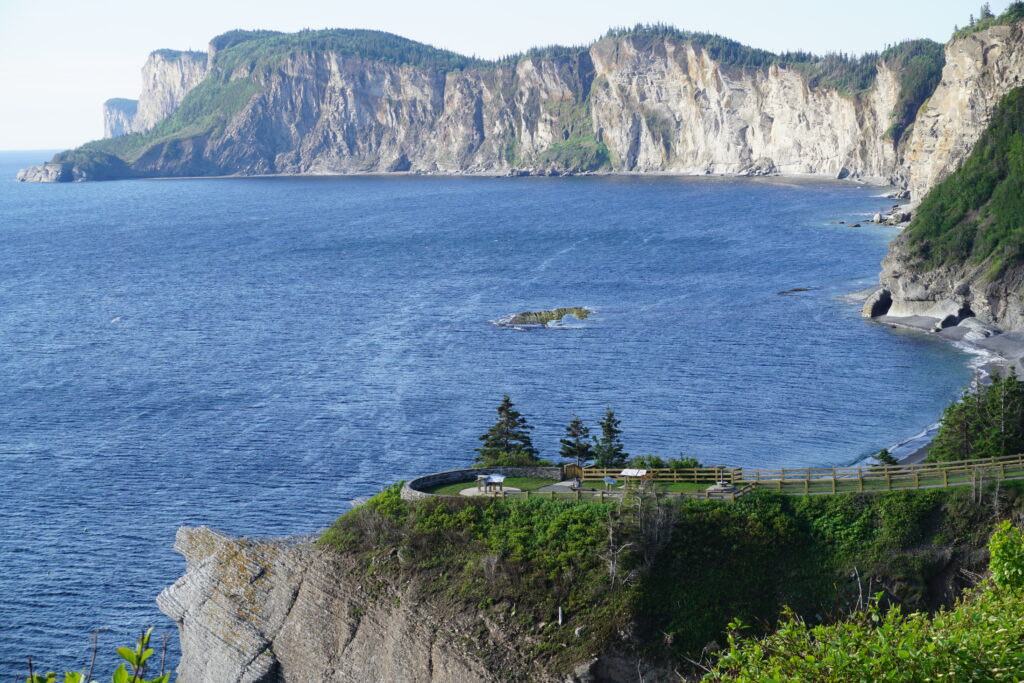
La Mauricie National Park
Mingan Archipelago National Park Reserve
Saskatchewan National Parks
Grasslands National Park
Grasslands National Park was established in 1981 in order to protect one of Canada’s largest remaining native prairie grasslands. The park is unique, as it is the only national park in Canada to represent the wide open prairie grasslands that Saskatchewan is famous for.
Grasslands National Park has two separate blocks: the West Block and the East Block, which are divided by private land that the government plans to acquire over time. The West Block is dominated by rolling prairie grasslands and the winding Frenchman Valley River, while the East Block landscape is more rugged with badlands terrain and dinosaur fossils.
As well as its special landscape and flora, Grasslands National Park is home to unique fauna who thrive in the rather harsh Saskatchewan climate. Plains bison were reintroduced into the park in 2005 after having disappeared for 120 years, and the park has the only native ‘towns’ of black tailed prairie dogs in Canada. You may also spot other wildlife including coyote, burrowing owls, rattlesnakes and deer.
The main activities in Grasslands National Park include marked and unmarked hiking trails through the wide open grasslands, driving the Ecotour Scenic Drive around the park’s West Block, spotting bison, prairie dogs and dinosaur fossils and start gazing in the Dark Sky Preserve.
Compared to some of Canada’s other national parks, Grasslands is relatively unvisited. Combined with the fact that you’re not restricted to trails and can even go back-country camping, this means that it’s perfectly possible to find your own untouched slice of paradise in Grasslands National Park.
Claire at The Adventurous Flashpacker
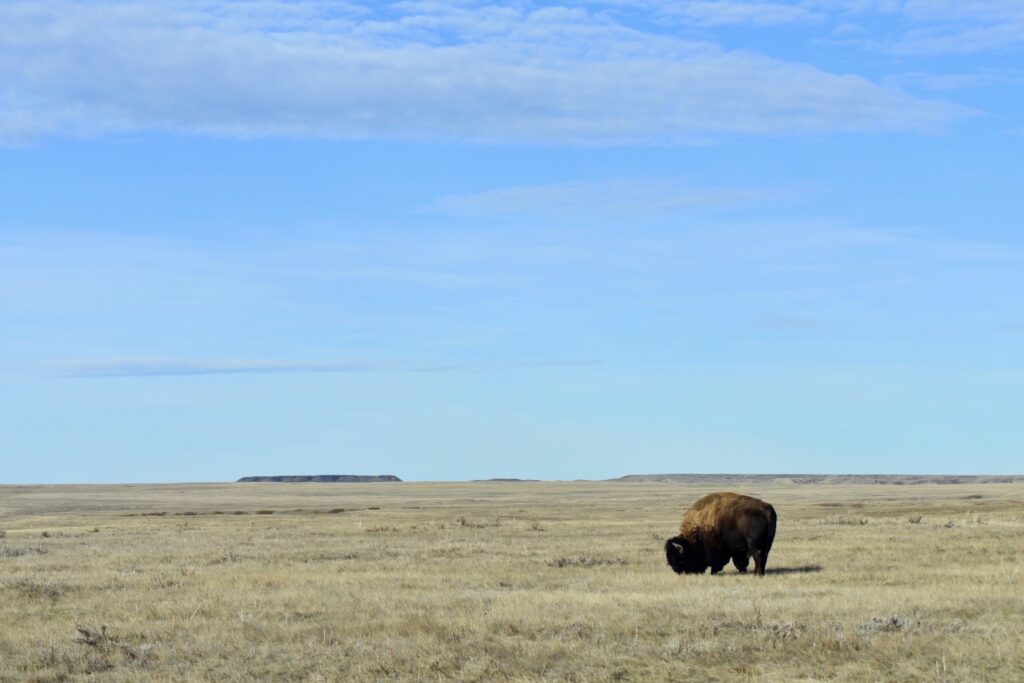
Prince Albert National Park
Yukon National Parks
Ivvavik National Park
Kluane National Park and Reserve
Kluane National Park and Reserve was created in 1972.
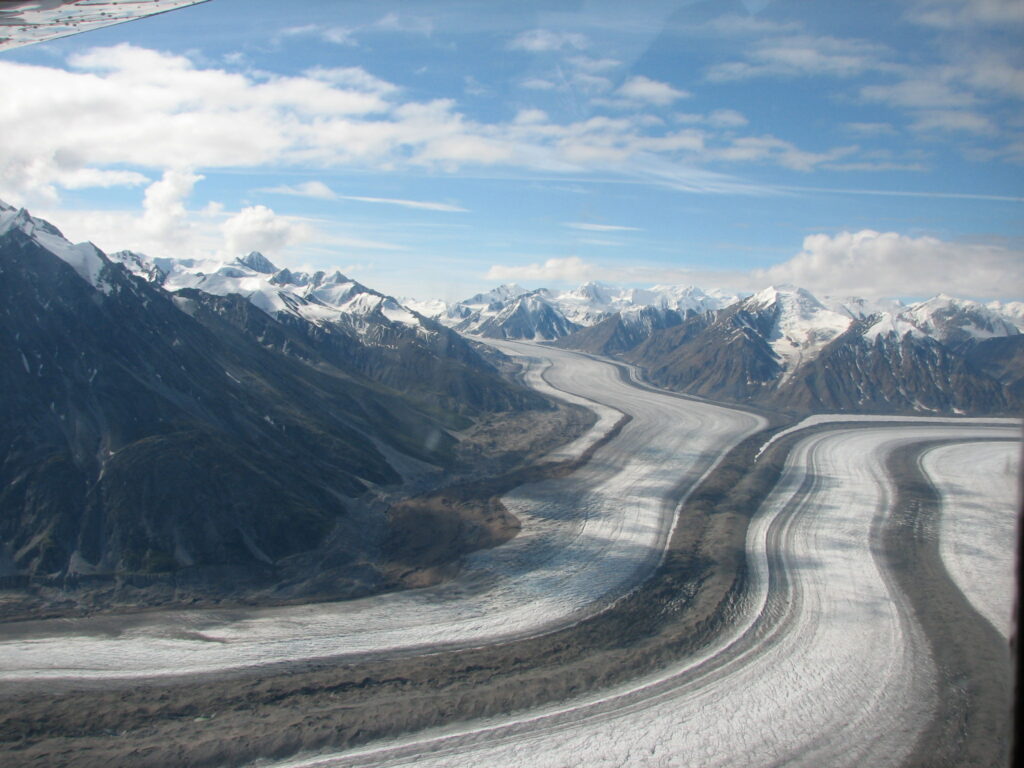
Vuntut National Park
Vuntut National Park was created in 1995.
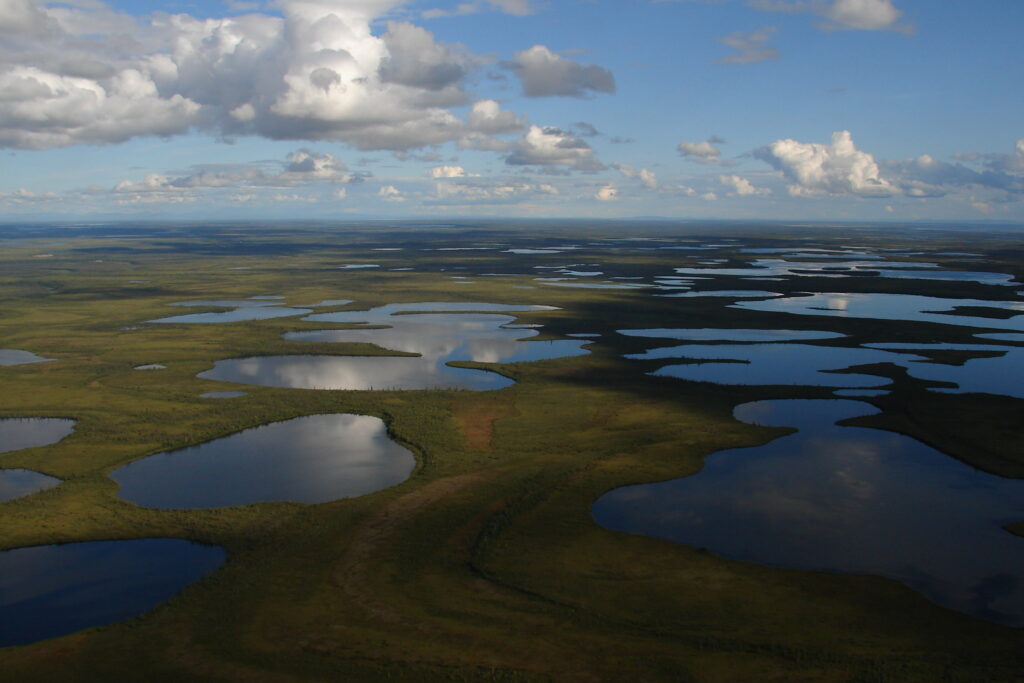

Jennifer Melroy
Hi, I'm Jennifer!
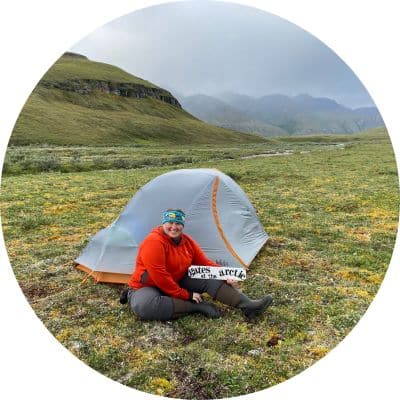
Welcome to the wonderful world of National Parks. I'm here to help you plan your NEXT amazing adventure through the United States National Parks and beyond. I want the national parks to be accessible to all.
I live in Tennessee, and when I'm home, you can find me hiking in the Smokies and the Cumberland Plateau.
58/63 National Parks
250+/423 National Park Units
Want to know more? Start Here.
Explore More
ACKNOWLEDGEMENT OF LAND
On this site, we promote travel to the United States and beyond that are the traditional lands of Indigenous and First Nations peoples.
With respect, I make a formal land acknowledgment, extending my appreciation and respect to these lands’ past and present people.
To learn more about the people who call these lands home, I invite you to explore Native Land.
DISCLAIMER
National Park Obsessed assumes no responsibility or liability for any errors or omissions in the content of this site (NationalParkObsessed.com). The information contained in this site is provided with no guarantees of completeness, accuracy, usefulness or timeliness. You are encouraged to conduct your own due diligence before acting on the information provided on this site and should not rely on the opinions expressed here.
There is an inherent risk in all outdoor recreation activities, the reader assumes all responsibility for their own personal safety.
DISCLOSURE
We are a participant in the Amazon Services LLC Associates Program, an affiliate program designed to provide a means for us to earn fees by linking to Amazon.com and affiliated sites.
Privacy Policy • About Us • Contact
Select stock photography provided depositphotos
Copyright ©2023 National Park Obsessed, LLC
Privacy Overview
Get a FREE 63 National Park Checklist
KICK START YOUR Planning
with the Ultimate National Park Planning Bundle.
This 162-page bundle includes a must see guide for each National Park along with a travel planner and the Beginners Guide to Planning a National Park Trip Planning eBook
Last Updated on 2 Sep 2020 by Jennifer Melroy

